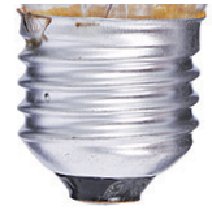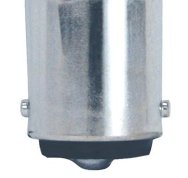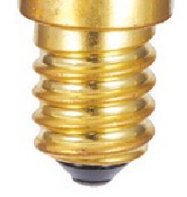How To Choose the Correct LED Light Globe
To make sure you always choose the right LED globe, we have created an easy step by step guide.
Step 1: choose the correct base
The base is the part of the globe that fits or screws into the socket, and is designated by a letter followed by a number (for example 'E27' which indicates 'Edison 27mm' - but that's not important to remember). Every light on this website will have its base type displayed in their specifications. Some of the more common types are shown below.

E27

B22

B15

E14
Tip If a light fitting has its globe type listed as SMD LED, LED array, COB (chip on board) LED or fixed LED it means that the light fitting comes with the globe which does not not have to be purchased and cannot be replaced. This is fine by the way, as LEDs have a lifetime longer than the light fitting itself.
Step 2: choose the correct wattage
You need to ensure that the globe Wattage is less than the maximum Wattage of the light. LED globes have low Wattages so it is quite unusual that you will have a problem here - but worth checking.
Warning A globe whose wattage is higher than the maximum Wattage rating of your light can be a fire hazard.
Step 3: choose the correct shape and size
There is a huge number of globe shapes and sizes - so many that the average consumer simply gets confused. This is particularly so for E27 and B22 globes (often used for indoor lights) where the range of sizes and shapes is vast. We recommend that you simply ignore these sizes and shapes, and choose a traditional normal-sized normal-shaped globe in every case.
Tip There are a few small exceptions to this hard rule: for example candle shaped globes look great in upright chandeliers, and fancy globes are beautifully suited for mirror and vanity lights.
Step 4: choose either dimmable or non-dimmable
This step can be ignored in most cases, as many lights - particularly outdoor lights - are not dimmable. Is is generally only applicable to indoor ceiling lights (such as pendants, spotlights and downlights). If you want to be able to change the brightness of the room to achieve the perfect atmosphere and ambience, you will most definitely want to buy a dimmable globe.
Tip Unless a globe says it is dimmable, you should assume it is not.
Tip Pendants are almost always dimmable so long as you purchase a globe that is dimmable.
Tip Don't forget that if you want a dimmable light, you need to have a dimmer in your circuit.
Step 5: choose either frosted or clear
The general rule of thumb is that frosted is the way to go if the globe is going to be in direct view. The advantage of frosted globes is that they diffuse light, avoid harsh shadows and improve the ambience - however their illumination is not as natural or as bright as clear globes.
Tip Some ceiling lights have globes protruding out the bottom, which will cause at least some of the globe to be naked. In those cases you will want frosted globes.
Step 6: choose the brightness
Ensure that the LED globe has the right brightness for the area you want. Remember that brightness is measured in Lumens (not Watts) so you need to get familiar with this.
Tip Most LED globes sit between 400 lumens at about 6W (converts to 40W on the old incandescent bulb scale) to 1300 lumens at about 15W (converts to 100W on the old incandescent bulb scale). Simply choose how bright you want based on this rough scale.
Tip We have a brightness guide on this website that explains Watts and Lumens, and compares brightness for the traditional incandescent, LED, CFL and halogen globes. Worth looking at.
Step 7: choose the colour temperature
We are now getting somewhat esoteric but here you want to choose between Warm White (2600K to 3200K), Cool White (3200K to 4500K) and Daylight White (4500K or more).
Tip The rule of thumb here is as follows: Warm White is best used in living rooms, dining rooms, bedrooms, hallways and outdoor areas to provide a relaxed effect. Cool White is best used in areas where clear, natural, fresh lighting is required for example in kitchens, studies, bathrooms, offices, workshops and retail outlets. Daylight White is best used in areas where you want a very bright effect, typically in industrial applications, hospitals and security lights.